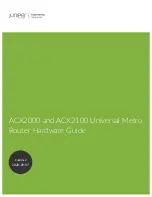
78 - 238
CCNA 2: Routers and Routing Basics v3.1 Instructor Guide – Module 7
Copyright
©
2004, Cisco Systems, Inc.
7.1.3 Defining a maximum count
The previous section described a situation in which slow convergence created the impression
that a fictitious path to a network existed, which leads to a routing loop. Routing loops have a
packet that circles a network, uses up bandwidth, and never reaches its destination. Distance
vector algorithms are designed to prevent these loops by defining a maximum hop count. This
value is known as a routing metric. A metric is the criteria used by a router to determine the
best path to a destination network. Metrics vary for different protocols. Some protocols such as
RIP use only the metric of hop counts. Other routing protocols may use bandwidth, delay, and
other factors. If the only metric used by a routing protocol is hop count then a router makes its
path determination decisions based on the lowest number of routers that a packet will have to
pass through to reach its destination.
The maximum hop count value defines how many routers a packet can pass through before
the destination network is unreachable. Each time a packet passes through a router the
distance number is increased. When the default or defined maximum is reached the network is
considered unreachable and the looping ceases. A non-technical example is a timed test. If
someone takes a timed test they have a predefined amount of time to complete it. When the
maximum amount of time has been reached, the test ends even if some questions have not
been answered.
7.1.4 Eliminating routing loops through split horizon
Another possible source for a routing loop occurs when incorrect information that has been
sent back to a router contradicts the correct information that it sent. The following example
explains how this problem occurs:
1. Router A passes an update to Router B and Router D that indicates that Network 1 is
down. Router C transmits an update to Router B that indicates that Network 1 is
available at a distance of four, by way of Router D. This does not violate split-horizon
rules.
2. Router B incorrectly concludes that Router C still has a valid path to Network 1 at a
less favorable metric. Router B sends an update to Router A to inform Router A of the
new route to Network 1.
3. Router A now determines that it can send to Network 1 by way of Router B, Router B
determines that it can send to Network 1 by way of Router C, and Router C determines
that it can send to Network 1 by way of Router D. Any packet that is introduced into this
environment will loop between routers.
4. Split-horizon attempts to avoid this situation. As shown in Figure
[1]
, if a routing update
about Network 1 arrives from Router A, Router B or Router D cannot send information
about Network 1 back to Router A. Split-horizon reduces incorrect routing information
and reduces routing overhead.
[2]
















































